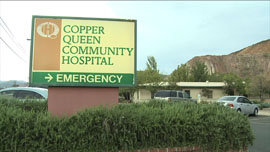Cronkite News has moved to a new home at cronkitenews.azpbs.org. Use this site to search archives from 2011 to May 2015. You can search the new site for current stories.
Report: Dental woes sending more Arizonans to emergency rooms
PHOENIX – The emergency room at Copper Queen Community Hospital in Bisbee is dealing with more toothaches these days.
“Patients are coming in with infections and abscesses, looking for antibiotics and pain medication,” said Jim Dickson, the hospital’s CEO.
From July through February, 58 people arrived at the hospital complaining of dental problems, he said, compared to 27 cases from July 2010 through June 2011.
Dickson attributed the rise in ER dental visits to the Arizona Health Care Cost Containment System, the state Medicaid program, cutting back on emergency dental care for adult patients in 2010.
A Pew Center on the States study found that between 2006 and 2009 preventable dental-related ER visits rose 61 percent in Arizona, compared to a 16 percent national increase during the same period.
Julie Stitzel, campaign manager for the group’s Children’s Dental Campaign, said the report suggests that nearly half of ER visits for dental problems are by AHCCCS recipients. Better funding for preventive dentistry could alleviate the problem, she said.
“The bad news is that in Arizona there has been a tremendous jump in preventable ER visits,” she said. “The good news is there is a real opportunity for the state to save money because these visits are totally preventable.”
Hospitals don’t typically have dentists on staff or the proper equipment to perform procedures such as root canals and extractions. Beyond prescribing pain medication and antibiotics, the most hospitals can do is refer a patient to a dentist.
The increase in ER dental visits also could be due to patients seeing decreases in dental care benefits offered by employers, according to Kevin Earle, executive director of the Arizona Dental Association.
In addition, Earle said, AHCCCS cuts have created a cost shift in low-income patients’ health care bills.
“Where AHCCCS used to spend for extraction from a dentist, a procedure costing less than $100, the state now has to pay for patients’ emergency room visits instead, when the issue becomes medical and not dental,” Earle said.
Visits to the ER can cost 10 times more than preventive care visits to the dentist’s office, according to the Pew Center study.
“If we’re going to be the custodians for the money used in health care, we should be utilizing the money in the most efficient way possible,” Earle said.
However, Monica Coury, an assistant director at AHCCCS, said the recent cuts involved a small program and couldn’t account for a major increase in ER visits for dental problems.
“It is a broader issue related to the fact that few adults have dental coverage,” she said. “Medicaid does not provide dental to adults and a lot of employer-sponsored insurance does not cover dental.”







